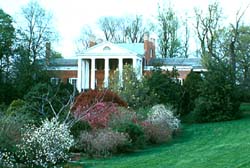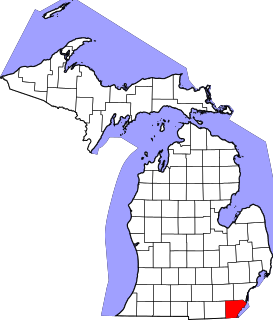
Waterloo is a city in Monroe County, Illinois, United States. The population was 9,811 at the 2010 census. It is the county seat of Monroe County.

Jordanville is a hamlet in the town of Warren, Herkimer County, New York. Jordanville is in the northwest part of Warren, at the intersection of New York State Route 167 and County Route 155. The community was settled by European Americans after the Revolutionary War and before 1791. Its name was derived from the nearby Ocquionis Creek, which was used by settlers for baptisms and likened by them to the Jordan River.

Oak Hill is a mansion and plantation located in Aldie, Virginia that was for 22 years a home of James Monroe, the fifth U.S. President. It is located approximately 9 miles (14 km) south of Leesburg on U.S. Route 15, in an unincorporated area of Loudoun County, Virginia. Its entrance is 10,300 feet (3,100 m) north of Gilberts Corner, the intersection of 15 with U.S. Route 50. It is a National Historic Landmark, but privately owned and not open to the public.

John Marshall Hamilton was the 18th Governor of Illinois, serving from 1883 to 1885. Born in Union County, Ohio, Hamilton became interested in politics at a young age, joining the Wide Awakes when he was thirteen and the Union Army four years later. After graduating from Ohio Wesleyan University he studied law and was admitted to the bar. A notable attorney in Bloomington, Illinois, Hamilton was elected to the Illinois Senate in 1876. He served there until 1881, when he was elected Lieutenant Governor of Illinois on a ticket with Shelby Moore Cullom. When Cullom resigned after election to the United States Senate, Hamilton became Governor of Illinois. He was not selected as a candidate for re-election, but did serve that year as a delegate to the 1884 Republican National Convention. He spent the rest of his life as an attorney in Chicago, where he died in 1905.

This is a list of properties and districts in Illinois that are on the National Register of Historic Places. There are over 1,800 in total. Of these, 85 are National Historic Landmarks. There are listings in all of the state's 102 counties.

This is a list of the National Register of Historic Places listings in Monroe County, Michigan.
This is a list of the 128 National Register of Historic Places listings in Cook County, Illinois outside Chicago and Evanston. Separate lists are provided for the 61 listed properties and historic districts in Evanston and the more than 350 listed properties and districts in Chicago. The Chicago Sanitary and Ship Canal Historic District extends through the West Side of Chicago, DuPage County and Will County to Lockport.

Highland, formerly Ash Lawn–Highland, located near Charlottesville, Virginia, United States, and adjacent to Thomas Jefferson's Monticello, was the estate of James Monroe, fifth President of the United States. Purchased in 1793, Monroe and his family permanently settled on the property in 1799 and lived at Highland for twenty-five years. Personal debt forced Monroe to sell the plantation in 1825. Before and after selling Highland, Monroe spent much of his time living at the plantation house at his large Oak Hill estate near Leesburg, Virginia.

Sweet Springs is an unincorporated community in Monroe County in the U.S. state of West Virginia. Sweet Springs lies at the intersection of West Virginia Route 3 and West Virginia Route 311.

The C. H. Moore Homestead, in Clinton, Illinois, is one of two Registered Historic Places in DeWitt County. The other, the Magill House, was added to the Register in 2003. The Moore House was added in 1979.

The Frank Lloyd Wright/Prairie School of Architecture Historic District is a residential neighborhood in the Cook County, Illinois village of Oak Park, United States. The Frank Lloyd Wright Historic District is both a federally designated historic district listed on the U.S. National Register of Historic Places and a local historic district within the village of Oak Park. The districts have differing boundaries and contributing properties, over 20 of which were designed by Frank Lloyd Wright, widely regarded as the greatest American architect.

Edward Echols was a U.S. political figure from the Commonwealth of Virginia. Echols held office as the 18th Lieutenant Governor of Virginia from 1898 to 1902.

The James Monroe Museum and Memorial Library is a historic museum at 908 Charles Street in Fredericksburg, Virginia. It is located on the site of the James Monroe Law Office, used by future United States President James Monroe from 1786 to 1789. It was declared a National Historic Landmark in 1966. It is now owned by the Commonwealth of Virginia and operated by the University of Mary Washington. The museum features original objects and memorabilia related to James Monroe, and includes items relating to other members of his family, including dresses worn by First Lady Elizabeth Monroe.
Moore House or Moore Farm may refer to:

Oak Grove is an unincorporated community in the Washington District of Westmoreland County, Virginia. The community, on the historic Northern Neck of Virginia, was a stagecoach stop in the early days of the Colony of Virginia

The Sawyer House, also known as the Sawyer Homestead and in its previous incarnation as the Navarre House, is a city-owned house located at 320 East Front Street in Monroe, Michigan. It was listed as a Michigan Historic Site on June 19, 1975. The house was listed on the National Register of Historic Places on November 23, 1977 and is also part of the larger Old Village Historic District.
Noble House may refer to:

James Monroe Family Home Site, also known as James Monroe's Birthplace, is a historic archaeological site located near Oak Grove and Colonial Beach, Westmoreland County, Virginia. The site includes the ruins of the Monroe Family Home and birthplace of President James Monroe, which were uncovered in 1976 by a team from the College of William & Mary. Monroe spent his entire youth working the farm until he left for his education at William & Mary, following which he served in the Continental Army. The archaeological team uncovered a house foundation measuring 20 feet by 58 feet. The known 1845 etchings of the birth home indicate a small four room, rough cut wooden farm house with few outbuildings on a 500-acre farm filled with wetlands.

The Lunsford-Pulcher Archeological Site is a prehistoric archaeological site in rural Monroe and St. Clair counties in Illinois. The site was the location of a Middle Mississippian village which was probably a satellite community of Cahokia. Several pyramidal burial mounds are included in the site. Archaeological excavations at the site have also discovered the remains of houses and garden beds, making the site one of the few Mississippian villages at which garden beds have been found. The site has been known to European settlers since early settlement of the area in the late 18th century; despite being used for farmland, the site remains in good condition.

The Moore-Jacobs House is a historic house at 500 North Main Street in Clarendon, Arkansas. It is a single-story wood frame structure, with a side-gable roof and an projecting entry pavilion with a pedimented gable supported by paired square columns. Built in about 1870, this Greek Revival house is a testament to that style's enduring popularity in Arkansas. It was moved across the street from its original location in 1931. It was also for many years home to Margaret Moore-Jacobs, known for her inspirational writings.
















